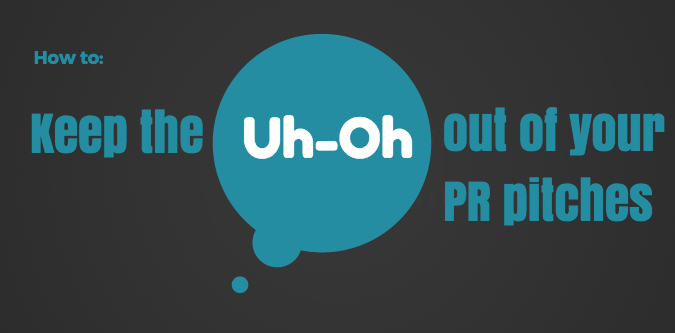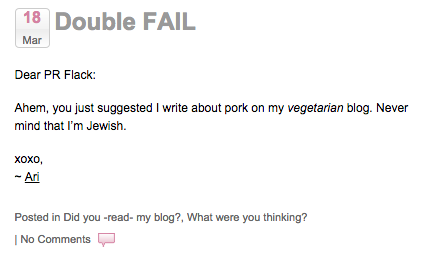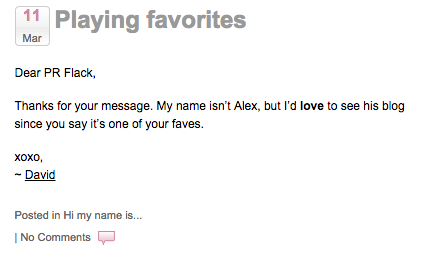Dos and Don’ts of PR Pitching: Six Tips to Influence the Media While Avoiding the PR “Walk of Shame”

Posted By Colleen Irish on March 10, 2015
One of the most essential secrets to success of any media relations program is the fine art of writing and pitching story ideas that inspire the press to write about your company or client. This is something we PR professionals spend years perfecting through research, relationship building and closely following target reporters in social networks to see what they're writing about and where their current interests lie. Because of this, I think we all tend to share the same reaction when we see a reporter call out a “bad PR pitch” on Twitter or any other online platform, there for the whole world to see.
I can't help feeling some sympathy for my fellow “PR flack,” as he or she is slammed by a prominent journalist for continuously stalking the writer with multiple e-mails after being politely informed the first time the material isn't the right fit. But at the same time, it's these pathetic instances that give the rest of us PR peeps a bad rap.
In most cases, these examples of bad PR pitches involve a junior-level person who is still learning the ropes. But in some cases, even more seasoned PR execs make the same mistakes -- with lasting repercussions for their own reputation, along with the company they're representing.
In a previous blog post I wrote about how to write a winning press pitch. But this time, I'd like to offer some basic Dos and Don'ts on how to avoid having your press pitch become the next headline for “bad PR” and instead become an amazing story idea a reporter just can't refuse. Here are my top six dos and don'ts:
1) DON'T randomly pitch a reporter from a database or media list; DO take the time first to get to know the specific reporter you should be pitching and his/her beat. These examples from the DearPRFlack.com blog demonstrate pitches that were most likely blindly sent out to a mass list of reporters, and in a hurried fashion. These lame attempts clearly are not going to win over the reporter on the receiving end of the e-mail, but instead put the PR person at risk for public ridicule and a permanent block on any future outreach.


2) DON'T blast a news release to your media targets; DO develop a tailored pitch to accompany a news release that explains how your announcement is timely and relevant. Contrary to popular belief, media coverage doesn't happen automatically just because a company has the coolest, most innovative, groundbreaking (or any “insert-name-of-superlative-here”) concept invented. You have to convince the press you have something truly different to share and go the extra mile to make the news relevant to other news or trends happening in the industry. But don't stretch the topic too far to match up to a certain trend, or your pitch will come across as forced or hokey.
Kevin Dugan of the Bad Pitch Blog cites an example of the downside of forcing a connection between your topic and a timely event. The news release issued during Black History Month, entitled Black Author's Book Teaser Will Make Your Kids a Slave to Reading, although chosen with the idea of inspiring children around the globe to read more, was instead considered in bad taste and was poorly received.
3) DON'T get bogged down with boring details or fancy jargon in your pitch; DO use a concise, creative writing style that gets right to the point, is cleverly constructed and fun to read. The average reporter gets close to 100 e-mail pitches a day, and the top guns get way more than that. So think about how your pitch can stand above the rest by appealing to the reporter's interests and individual style, while delivering an entertaining read. Pitches that are impossible to understand because they're filled with industry buzzwords and a long-winded introduction will lose the reporter's interest before they even get to the heart of the matter.
4) DON'T neglect to follow up on your pitch; DO remember to pick up the phone for person-to-person communication. The telephone used to be a PR person's primary tool for the majority of their pitching and follow up, and the channel to build and maintain media relationships. Today, with all the other tools we use (e-mail, social media, texting, etc.), too many in our industry have forgotten the importance of a real, live conversation. Many reporters suggest that PR reps send one e-mail follow up on their pitch a day or two later, as a brief reminder. However, phone follow up remains a very important tactic for catching a reporter live, offering more information, answering questions and truly securing interest.
5) DON'T ignore social media sources for relationship building; DO use Twitter, LinkedIn and other social platforms wisely. Social media offers an additional channel to learn more about the reporter you're targeting by following them and keeping an eye on what they're writing about, learning more about their interests, and often times engaging in an online conversation. Be mindful not to misuse Twitter or other social tools as a means for pitching a reporter. This can only backfire, with you being shamed along with others for poor PR etiquette.
Remember: your goal as a PR representative is to capture the interest of the media and inspire them to write about your client or company. The best way to accomplish this is by keeping the reporter's job and their pain points top of mind as you're pitching them. Reporters are storytellers. Help make their job easier by tipping them off on a good story to tell -- and before you know it, you just may find yourself in a win-win situation, with a lasting relationship to boot.
For more insights, check out the following article from Busszumo, which offers a collection of tips from top reporters at TechCrunch, New York Times and more.



